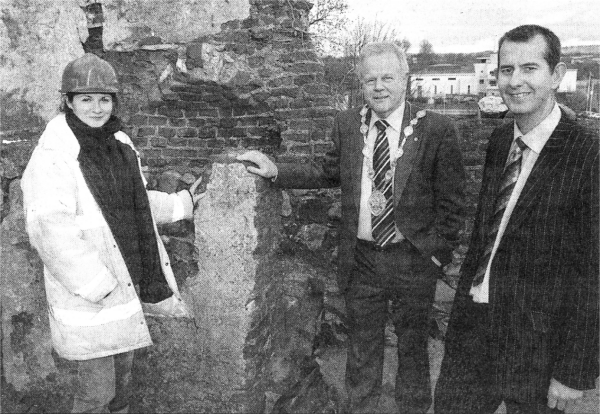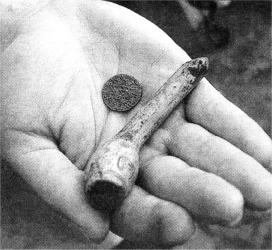
Chairman of the Council's
Economic Development Committee, Alderman Edwin
Poets and Mayor Councillor Trevor Lunn receive a
tour of the latest 'archaeological finds' at
Castle Gardens with Stephanie McMullen of
Archaeology Development Services.
A TANTALISING glimpse of life in 17th century
Lisburn has been thrown up by the Castle Gardens Restoration
Project.
Excavation work on the site, part of a �4
million Lisburn City Council and Heritage Lottery Fund
restoration scheme, has unearthed some remarkable finds
including building structures, metalwork and coinage.
One of the most exciting discoveries is the
perfectly intact clay tiled basement floor of the 17th Century
Gazebo (summer house). There are four steps leading from what
was the bowling green into the main entrance of the Gazebo.

One of the
perfectly preserved trader's
tokens (coins) and a clay pipe
which were uncovered.
Several theories have been put forward as to the function of
this building.
Following the discovery of what seems to be a
fireplace with two smaller ovens, experts suggested that the
Gazebo may have been a gardener's residence, housing for a small
garrison of soldiers, or the remains of a bakery servicing the
castle.
However, recent finds of pottery, glass, a
decorative pin brooch/dress pin and a carved bone gaming piece,
suggest this building was more likely to have been used for
recreations. It may have been a type of summer house, used
primarily for socialising by the Conway family.
Preparing
The ovens uncovered below are thought to have
provided a means of preparing and cooking food within the
bowling green. This excavation work is all the more remarkable
as before the 2003 archaeological assessment, the Gazebo was not
even visible above the ground. This find will be part of the
restored gardens.
Several perfectly preserved traders' tokens
(coins) have also been unearthed and further investigation by
local historian, Shaun Cheyne, has revealed that one of the
tokens has a local connection with the name Edward Moore,
Lisburn and is dated 1666.
A copy of Moore's will has also been found,
containing interesting historical facts about Lisburn and its
people.
The will discloses that shop owner Moore owed
considerable sums of money to various local people, all of whom
are named in the will, along with the amounts owed.
Other documents state that Edward Moore
married Mary Jackson from Lisburn on the 2nd February 1667 in
Christ Church Cathedral, Lisburn.
Their three sons Roger, Edward and John were all
baptised in the Cathedral.
|
* The second and final stage of
the scheme will make the gardens more accessible
from the City centre with a new entrance way in
Bridge Street allowing access directly into the
park. The entrance via the Cathedral grounds to the
Irish Linen Centre & Lisburn Museum will also be
improved.
* The cast iron railings and
monuments in the Victorian, or upper, part of the
Gardens off Castle Street are being fully restored,
along with the many beautiful scheduled monuments in
the Gardens.
*A new park warden's office is
being constructed which will include public toilets
and education facilities at the location of the
World War II air raid shelter at the Castle Street
pedestrian entrance. The 17th Century terrace walls,
terraces and stone perron are also being fully
restored.
* Upon completion of the
restoration of the Gardens, a dedicated Education
Officer, will work with Museum staff to deliver the
education programme working closely with a Park
Ranger managing the restored Gardens.
*The restoration of the Gardens will
be completed in July 2007. |